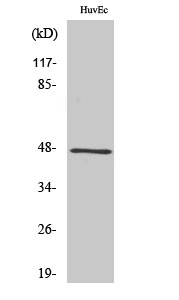Recombinant Human Neurocalcin-δ/NCALD
| Product name: | Recombinant Human Neurocalcin-δ/NCALD |
| Source: | E.coli |
| Purity: | Greater than 95% as determined by reducing SDS-PAGE. |
| Buffer Formulation: | Supplied as a 0.2 μm filtered solution of 20mM TrisHCl, 100mM NaCl, 1mM DTT, 40% Glycerol, pH 8.0. |
| Applications: | Applications:SDS-PAGE; WB; ELISA; IP. |
| Storage: | Avoid repeated freeze/thaw cycles. Store at 2-8 oC for one month. Aliquot and store at -80 oC for 12 months. |
| UOM: | 100ug/50ug/200ug/1mg/1g |
| Source | E.coli |
| Description | Recombinant Human Neurocalcin-delta is produced by our E.coli expression system and the target gene encoding Met1-Phe193 is expressed with a 6His tag at the N-terminus. |
| Names | Neurocalcin-Delta, NCALD |
| Accession # | P61601 |
| Formulation | Supplied as a 0.2 μm filtered solution of 20mM TrisHCl, 100mM NaCl, 1mM DTT, 40% Glycerol, pH 8.0. |
| Shipping |
The product is shipped on dry ice/ice packs. |
| Storage |
Store at < -20°C, stable for 6 months after receipt. Please minimize freeze-thaw cycles. |
| Purity |
Greater than 95% as determined by reducing SDS-PAGE. |
| Endotoxin | Less than 0.1 ng/µg (1 IEU/µg) as determined by LAL test. |
| Amino Acid Sequence |
MGSSHHHHHHSSGLVPRGSHMGKQNSKLRPEVMQDLLESTDFTEHEIQEWYKGFLRDCPSGHLSM EEFKKIYGNFFPYGDASKFAEHVFRTFDANGDGTIDFREFIIALSVTSRGKLEQKLKWAFSMYDL DGNGYISKAEMLEIVQAIYKMVSSVMKMPEDESTPEKRTEKIFRQMDTNRDGKLSLEEFIRGAKS DPSIVRLLQCDPSSAGQF
|
| Background | Neurocalcin-delta (NCALD) is a neuronal calcium-binding protein that belongs to the neuronal calcium sensor (NCS) family. It expressed in mammalian brains. NCALD contains an N-terminal myristoylation signal and four EF-hand calcium binding loops. The protein possesses a Ca2+ /myristoyl switch. It is cytosolic at resting calcium levels. However, elevated intracellular calcium levels induce a conformational change which exposes the myristoyl group, resulting in protein association with membranes and partial co-localization with the perinuclear trans-golgi network. NCALD protein is thought to be a regulator of G protein-coupled receptor signal transduction. |














